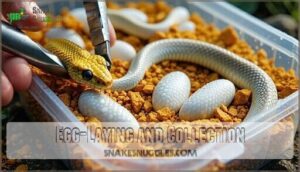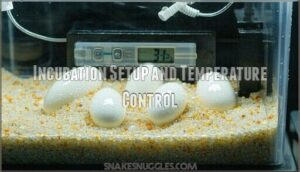This site is supported by our readers. We may earn a commission, at no cost to you, if you purchase through links.

After mating, eggs incubate for about 60 days at 78-82°F. Profitable morphs like Palmetto command higher prices, but even normals sell well with good marketing.
Build your reputation through social media and reliable shipping practices. The real money’s in understanding which genetics produce the most sought-after offspring.
Table Of Contents
- Key Takeaways
- Setting Up Your Corn Snake Breeding Operation
- Preparing Corn Snakes for Successful Breeding
- Incubating Eggs and Raising Hatchlings
- Navigating Legal and Regulatory Requirements
- Marketing and Selling Your Corn Snakes
- Frequently Asked Questions (FAQs)
- How do I handle feeding challenges with baby corn snakes?
- Is breeding corn snakes a profitable endeavor?
- What genetic combinations produce albino offspring?
- How long do corn snakes live?
- What temperatures cause egg binding problems?
- Which morphs have known health issues?
- How do you treat respiratory infections?
- Conclusion
Key Takeaways
- You’ll need proper housing with 40-gallon enclosures, temperature gradients of 75-85°F, and 50-60% humidity to create the right breeding environment for your corn snakes.
- Wait until females reach 300+ grams and use brumation (6-10 week cooling period at 50-60°F) to trigger successful breeding behavior and mating readiness.
- Focus on profitable morphs like Palmetto that sell for $500-$900 versus standard corn snakes at $40-$80, and maintain detailed records for legal compliance and breeding documentation.
- Build your reputation through social media marketing, reliable overnight shipping with proper insulation, and excellent customer service including health guarantees and post-sale support.
Setting Up Your Corn Snake Breeding Operation
Setting up your breeding operation starts with creating the right environment for your corn snakes to thrive and reproduce successfully. You’ll need proper housing with controlled temperatures and humidity levels, along with separate spaces for breeding pairs, gravid females, and growing hatchlings.
Housing and Environmental Requirements
Before diving into breeds breeding, you’ll need proper housing that mimics natural conditions. Your enclosure size should be at least 40 gallons for adult pairs, with secure lids preventing escapes.
Create a temperature gradient from 75-85°F using under-tank heaters. Maintain humidity levels around 50-60% with water bowls. Choose substrate like aspen shavings for easy cleaning.
Add hiding spots and branches for enrichment needs during animal reproduction cycles. A suitable habitat requires a quality corn snake enclosure.
Essential Equipment and Supplies
Before you can reproduce healthy offspring, you’ll need the right tools for successful animal reproduction. Smart breeders invest in quality equipment that ensures their corn snakes thrive and produce strong hatchlings.
Essential breeding supplies include:
- Heating systems with thermostats for precise temperature control
- Humidity control devices like misters or water bowls
- Appropriate enclosure size containers for breeding pairs
- Safe substrate choices that retain moisture during egg-laying
- Feeding tools including tongs and appropriately-sized prey
A vital element is a reliable temperature regulator.
Preparing Corn Snakes for Successful Breeding
You’ll need to prepare your corn snakes carefully before breeding season starts, focusing on their age, weight, and health status. The key steps include checking if they’re sexually mature, putting them through brumation (a cooling period), and then pairing compatible snakes for mating.
Determining Sex and Sexual Maturity
Accurate visual sexing starts around six months old when you’ll spot maturity signs. Males develop thicker tail bases while females show gradual tapering. The popping technique works best for young snakes—gently press near the vent to reveal hemipenes in males. For adults, probe usage offers reliable results when done carefully.
Wait until females reach breeding weight of 300+ grams before attempting sexual reproduction and mating to produce healthy offspring.
Brumation and Conditioning Techniques
Most breeders know that temperature cycling triggers successful breeding in corn snakes. You’ll need to cool your snakes for 6-10 weeks at 50-60°F to simulate winter conditions. This brumation length readies their bodies for sexual reproduction and mating season. Increased breeding success is a noted benefit of this cooling period.
- Hydration strategies: Keep water available but reduce humidity to prevent shedding issues during cooling
- Post-brumation feeding: Gradually warm snakes and offer small meals before introducing potential mates
- Monitor behavior: Watch for increased activity signaling readiness to produce offspring
Pairing and Mating Process
Once you’ve completed brumation, introduce your male to the female’s enclosure for controlled mating. Watch for fertility signs like the female’s receptive posturing and tail lifting. Copulation duration usually lasts 2-4 hours.
Remove the male afterward and provide post-mating care with extra hiding spots. Your pairing strategies should focus on proven mating behaviors to produce quality offspring.
Incubating Eggs and Raising Hatchlings
Once your corn snakes mate successfully, you’ll need to master egg incubation to turn those precious clutches into healthy hatchlings.
The next 60-75 days require careful temperature control and patience, but watching those first babies emerge makes every sleepless night worth it.
Egg-Laying and Collection
After successful mating, your female will lay eggs 30-45 days later. Watch for restless behavior and substrate digging—she’s seeking the perfect spot.
Clutch size usually ranges from 10-30 eggs, depending on her age and size. Carefully collect eggs within hours of laying, checking egg viability through gentle candling.
Double clutching can produce young twice per season.
Incubation Setup and Temperature Control
Once you’ve collected those precious eggs, getting the incubation setup right determines whether you’ll celebrate healthy offspring or face disappointing hatching issues. Temperature stability reigns paramount when you want to successfully reproduce your prized breeding pairs. A vital aspect involves ensuring the eggs are placed in a container with moist incubation substrate to maintain proper humidity.
- Incubator Types: Commercial reptile incubators work great, but homemade setups using plastic containers and heat sources can produce young just as well
- Temperature Range: Maintain 78-82°F consistently, with 82°F being the sweet spot for corn snake mating success
- Humidity Levels: Keep substrate slightly damp but not soggy to prevent mold growth
- Egg Candling: Check development weekly with a flashlight after day 14
Hatchling Care and First Feeding
Your newly hatched offspring need immediate attention after emerging from their shells. Set up small enclosures with proper hatchling hydration through water dishes and humid hides. Watch for shedding issues during their first shed within ten days.
When animals won’t eat, try scenting food with mouse scent or brain matter. Handle these delicate creatures minimally until they reproduce their first successful feeding response.
Navigating Legal and Regulatory Requirements
You’ll need permits and proper registration in most states before you can legally sell your corn snakes, and trust me, getting caught without them isn’t worth the headache.
Keep detailed records of every hatch date, sale, and morph because inspectors love their paperwork, and some states won’t let you sell native-looking morphs to protect wild populations.
Permits and Breeder Registration
Before launching your breeding population, you’ll need to navigate state regulations that vary dramatically across the country. Many states require permits costing $10-$305 annually, especially for native corn snake morphs that impact conservation efforts. In contrast to the US, EU laws emphasize welfare and ethics more strongly.
Here’s your permit checklist:
- Contact your state wildlife agency to determine specific breeding requirements and morph restrictions in your area
- Register as a breeder with required documentation proving your selective breeding setup meets facility standards
- Plan for inspections as controlled mating operations often require compliance visits for sales authorization
Record-Keeping and Documentation
Track every breeding cycle like your business depends on it—because it does. Maintain detailed Sales Records for each offspring you sell, including buyer information and dates. Keep thorough Breeding Logs documenting which strains produce specific morphs.
Document Health Records for all breeding pairs and their offspring. Record Morph Lineage to prove genetic authenticity.
This paperwork ensures Regulatory Compliance and protects your selective breeding investments when authorities come knocking.
Regulations on Morphs and Wild Types
Understanding morph legality prevents costly mistakes when breeding corn snakes. Wild-type bans protect native populations from illegal collection, while morphs prove captive breeding. States restrict wild types to maintain genetic integrity and conservation impact. Genetic variations create diverse color patterns.
- Check your state’s approved morph list before breeding – regulations change frequently
- Maintain permit compliance through proper documentation of all offspring genetics
- Focus selective breeding on distinctive morphs that clearly differ from wild populations
Marketing and Selling Your Corn Snakes
Once you’ve got healthy hatchlings and proper paperwork sorted out, it’s time to turn your breeding efforts into profit. You’ll need to identify which morphs bring the best prices, build strong sales channels, and master the shipping process to keep customers happy and coming back for more.
Identifying Profitable Morphs and Pricing
With legal requirements handled, you can focus on profitable breeding decisions. Morph popularity drives your success—Palmetto and Scaleless strains command $500-$900 while standard breeds sell for $40-$80.
Premium morphs like Palmetto and Scaleless can sell for $500-$900 compared to standard corn snakes at $40-$80
Market trends show complex genetic traits boost pricing strategies substantially. Rarity influence matters most when selecting breeding pairs. Target offspring combining popular morphs like Tessera x Miami for premium returns on new strains.
Building an Online Presence and Sales Channels
Your pricing strategy means little without visibility. Building your online presence starts with choosing reliable E-commerce Platforms like MorphMarket for reptile-focused sales.
Social Media drives over 60% of buyer inquiries—post breeding updates, offspring photos, and care tips regularly. Content Marketing through species guides boosts credibility, while Online Advertising targets specific morph collectors.
Setting competitive prices is also essential for maximizing profits.
Community Engagement in forums establishes you as a trusted breeder who produces quality animals that reproduce successfully.
Shipping, Customer Service, and After-Sale Support
Once you’ve built your online presence, customer trust depends on safe shipping practices and clear communication. Your reputation as a breeder hinges on how well you handle the entire customer experience. Here’s your action plan:
- Safe shipping practices – Use insulated boxes with heat/cold packs, ship overnight during mild weather, and provide tracking numbers for peace of mind.
- Customer communication – Send care sheets with every purchase, offer post-sale guidance via phone or email, and maintain open dialogue about your animals’ health.
- Health guarantees – Provide 7-14 day health guarantees, establish clear problem resolution procedures, and replace or refund animals that don’t reproduce as expected.
To guarantee safe transport, consider investing in specialized shipping products.
Frequently Asked Questions (FAQs)
How do I handle feeding challenges with baby corn snakes?
Feeding baby corn snakes isn’t rocket science, but it sure feels like it sometimes! **Start with frozen-thawed pinkies warmed to room temperature.
**
If they’re stubborn, try offering food in evening darkness when they’re naturally active. **Sometimes a gentle tap on their nose with the pinkie works wonders.
Is breeding corn snakes a profitable endeavor?
You’ll likely break even rather than get rich. Most breeders report small profits under $1,000 annually, with hourly wages around 5p when factoring time investment.
Think hobby with benefits, not business goldmine.
What genetic combinations produce albino offspring?
You’ll get albino offspring by pairing two albino corn snakes together—that’s the guaranteed method.
Otherwise, you can breed an albino with a het (hidden carrier) or two hets together, but you’ll face genetic uncertainty.
How long do corn snakes live?
Time flies when you’re caring for corn snakes! You’ll enjoy your companion for 15-23 years in captivity, much longer than their wild counterparts who usually live 10-15 years.
What temperatures cause egg binding problems?
Temperatures below 77°F or above 86°F during incubation cause egg binding problems. Temperatures higher than 30°C (86°F) or lower than 25°C (77°F) can lead to developmental issues.
Keep it steady at 80-84°F for best results.
Which morphs have known health issues?
Walking into genetic minefields isn’t wise. Stargazing syndrome, which affects balance and coordination, is one such issue to avoid. This condition causes neurological disorders affecting the vestibular system .
Some sunkissed lines carry this recessive trait, making breeding risky without proper testing.
How do you treat respiratory infections?
You’ll need a reptile vet ASAP for proper antibiotics. Don’t attempt home treatment—this requires professional diagnosis and prescription medications.
Meanwhile, increase basking temperatures and fix humidity levels to support recovery.
Conclusion
Picture yourself watching those first hatchlings emerge from their shells—tiny perfect replicas ready to find new homes. Success in how to breed and sell corn snakes comes down to patience, attention to detail, and building trust with customers.
You’ve got the roadmap now: proper housing, conditioning techniques, incubation skills, and marketing strategies. **Start small, learn from each clutch, and grow your operation gradually.
**
With dedication and quality animals, you’ll build a thriving breeding business that brings joy to reptile enthusiasts everywhere.
- https://exoticskeeper.com/blog/corn-snakes-in-the-wild-amp-history-of-captive-breeding/
- https://en.wikipedia.org/wiki/Corn_snake
- https://animaldiversity.org/accounts/Pantherophis_guttatus/
- https://reptilesmagazine.com/color-patterns-of-corn-snakes-determined-by-single-gene/
- https://sites.pitt.edu/~mcs2/herp/genetics.html














